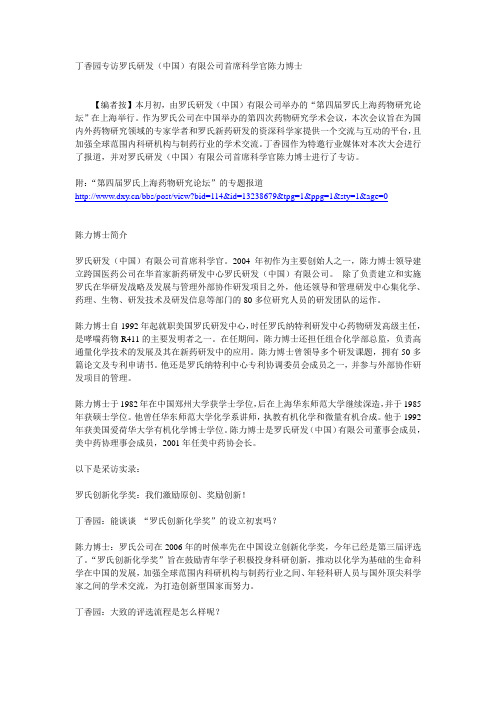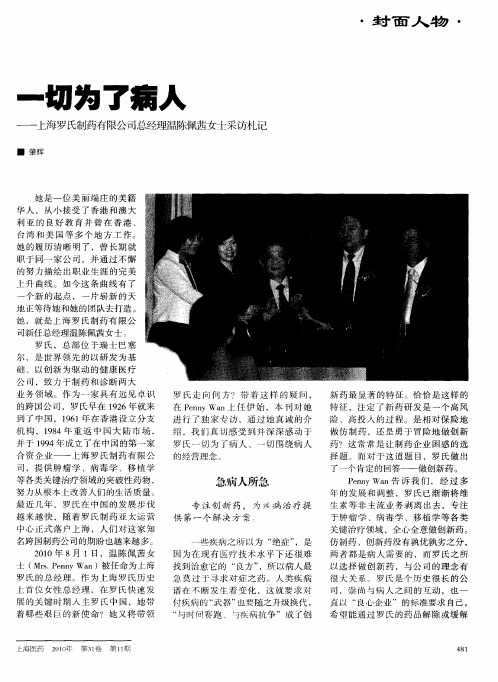上海罗氏关于SAS programmer的讲座
- 格式:pdf
- 大小:1.27 MB
- 文档页数:88

丁香园专访罗氏研发(中国)有限公司首席科学官陈力博士【编者按】本月初,由罗氏研发(中国)有限公司举办的“第四届罗氏上海药物研究论坛”在上海举行。
作为罗氏公司在中国举办的第四次药物研究学术会议,本次会议旨在为国内外药物研究领域的专家学者和罗氏新药研发的资深科学家提供一个交流与互动的平台,且加强全球范围内科研机构与制药行业的学术交流。
丁香园作为特邀行业媒体对本次大会进行了报道,并对罗氏研发(中国)有限公司首席科学官陈力博士进行了专访。
附:“第四届罗氏上海药物研究论坛”的专题报道/bbs/post/view?bid=114&id=13238679&tpg=1&ppg=1&sty=1&age=0陈力博士简介罗氏研发(中国)有限公司首席科学官。
2004年初作为主要创始人之一,陈力博士领导建立跨国医药公司在华首家新药研发中心罗氏研发(中国)有限公司。
除了负责建立和实施罗氏在华研发战略及发展与管理外部协作研发项目之外,他还领导和管理研发中心集化学、药理、生物、研发技术及研发信息等部门的80多位研究人员的研发团队的运作。
陈力博士自1992年起就职美国罗氏研发中心,时任罗氏纳特利研发中心药物研发高级主任,是哮喘药物R411的主要发明者之一。
在任期间,陈力博士还担任组合化学部总监,负责高通量化学技术的发展及其在新药研发中的应用。
陈力博士曾领导多个研发课题,拥有50多篇论文及专利申请书。
他还是罗氏纳特利中心专利协调委员会成员之一,并参与外部协作研发项目的管理。
陈力博士于1982年在中国郑州大学获学士学位,后在上海华东师范大学继续深造,并于1985年获硕士学位。
他曾任华东师范大学化学系讲师,执教有机化学和微量有机合成。
他于1992年获美国爱荷华大学有机化学博士学位。
陈力博士是罗氏研发(中国)有限公司董事会成员,美中药协理事会成员,2001年任美中药协会长。
以下是采访实录:罗氏创新化学奖:我们激励原创、奖励创新!丁香园:能谈谈“罗氏创新化学奖”的设立初衷吗?陈力博士:罗氏公司在2006年的时候率先在中国设立创新化学奖,今年已经是第三届评选了。


罗氏血气cobas b 123 POC system安装与培训流程一、检查仪器、试剂、环境准备情况,如果达到要求则连接电源并安装仪器。
二、介绍仪器整体情况。
三、开机,按照屏幕提示执行9步操作并详细介绍。
四、测定程序介绍、示范。
五、更换试剂耗材步骤介绍、示范。
六、介绍各个页面功能:[综述][工作区][仪器][效用]七、让学习人员自己动手操作样本检测、耗材更换,培训工程师当场进行监督、指导。
非常重要!正确的操作会大大减少不必要的故障。
八、强调注意事项:1、血液抗凝必须处理好,检测前充分混合(不能过于剧烈,防止溶血)。
2、建议采血使用动脉血气针;如果使用肝素化的注射器,建议使用2mL容量的型号,采血量要达到1.5mL;如果是5mL容量的注射器,采血量要达到3mL。
3、操作者务必仔细察看屏幕,严格按照屏幕上的指示进行操作,操作者确实完成屏幕指示的动作后,再按下按钮确认。
尤其是更换Sensor Cartridge,请务必仔细观察屏幕指示,做到正确安装。
4、更换Sensor Cartridge后,选择[效用]菜单,用新鲜的血浆(当天的标本)做8次Sensor Cartridge 常规浸润,再做1次Sensor Cartridge 内部常规湿化,接着系统会自动定标,如果有飘红的重复以上步骤浸润和湿化步骤,直至全部项目通过定标。
然后再做两个新鲜全血样本(当天的标本)的测定,进一步活化Sensor Cartridge,整个过程大概需要20多分钟。
请务必在刚刚更换Sensor Cartridge后做好上述活化步骤,过了一段时间再做效果会大大降低。
5、提示使用科室:请保留所有的Sensor Cartridge银色包装袋以及因故障更换下来的Fluid Pack,这些是工程师与罗氏厂家交流维修资料的依据。
九、交流和答疑。
十、留下使用说明和操作快速指南,在仪器合适位置放置工程师名片。
罗氏血气分析仪 cobas b 123 POC system 检测操作快速指南首先按下[综述]菜单,A、注射器样本:1、将注射器内头三滴(连同气体)一起排出,轻轻颠倒注射器、搓动注射器(建议每个动作都大于10次,动作要轻,防止溶血),充分混合样本。


华领医药成功举办中国⾸个糖尿病全球原创新药第四代葡萄糖激酶激活华领医药成功举办中国⾸个糖尿病全球原创新药第四代葡萄糖激酶激活剂HMS5552Ⅱ期临床研究者会中国南京,2015年4⽉3⽇华领医药技术(上海)有限公司(以下简称华领医药)今⽇于南京⽞武饭店举⾏中国⾸个糖尿病全球原创新药——第四代葡萄糖激酶激活剂HMS5552的Ⅱ期临床研究者会。
本次会议由包括研究牵头单位南京⼤学医学院附属⿎楼医院在内的20余家国内临床试验机构及专家参加,由南京⿎楼医院内分泌科主任、中华医学会糖尿病学分会副主委朱⼤龙教授主持。
会议讨论了华领医药产品HMS5552的Ⅰ期临床研究结果及Ⅱ期临床研究⽅案,与会专家充分肯定了Ⅰ期临床研究设计和实施的科学性和完整性,对药物的安全性和有效性指标给予了积极评价,对下⼀阶段临床研究的顺利开展提出了建设性的意见。
专家寄语南京⿎楼医院朱⼤龙教授:“华领医药的葡萄糖激酶激活剂(GKA)项⽬从2013年开始⾄今已完成3项⾼质量的临床研究,这为快速科学地探索创新药物对于中国糖尿病受试者的治疗价值创⽴了⼀个典范。
在Ⅰ期临床研究过程中,每当⼀个剂量组⽤药观察结束,下⼀个剂量研究都必须通过研究者及相关科研⼈员的充分讨论,达成意见⼀致后⽅可开展。
所有研究者秉承确保受试者安全的医学伦理原则,科学、客观地做出每⼀项决定。
在HMS5552的Ⅱ期临床研究中,研究者将会继续保持良好沟通,患者优先的传统,⾼质量地完成受试者的长期⽤药观察,认真、细致、严谨地对待每⼀个数据,对每⼀位患者负责。
”纪⽴农教授:“葡萄糖激酶(GK)于上世纪90年代克隆成功,并被发现与糖尿病密切相关。
作为感应器,GK可以感应⾎糖变化,从⽽调控β细胞,分泌胰岛素,因⽽倍受医药研发企业的关注。
现有的胰岛素促分泌剂容易造成患者体重增加以及低⾎糖的发⽣。
从⽬前的临床研究数据来看,HMS5552的低⾎糖风险很低。
其次,由于华领医药独特的研发模式,使得临床试验能够快速、⾼效、⾼质量地开展,HMS5552很有希望成为中国⼈⾃⼰研发的全球first-in-class新药。

赵桂玉博士(华领医药)彭瑞玲总经理(医普科诺)使用JMP Clinical进行有效的临床试验数据监测:设想、应用及药厂与CRO的合作赵桂玉博士▪华领医药医学数据科学负责人,目前的主要工作为临床试验数据的管理和统计分析,围绕临床试验打造集中化数据质量管理体系,以保障数据的完整性和分析结果的内部一致性▪兴趣:统计学在临床试验中的应用,医学大数据,慢病管理▪教育经历:博士:University of North Carolina at Chapel Hill本科:北京大学医学部▪华领医药成立于2011年,是一家致力于成为世界领先、专注于糖尿病等慢性病个性化治疗的创新型企业。
发言摘要▪JMP Clinical在临床试验数据审核中的作用:强大的可视化功能▪互动型的图形有助于从多角度审阅受试者的状况,揭示药物-药物以及药物-疾病之间的深层关系▪有助于内部数据监查员以及审评机构快速并全面的理解和评估临床试验数据▪利于医生和统计师之间的沟通,以及后续的申办方和审评机构之间的沟通▪JMP Clinical在临床试验数据质量监测中的作用:试验进行中的监查▪医学/药物安全监测(Medical/Safety Monitoring)▪质量保证(Quality Assurance)▪基于风险的质量监查(Risk-based Monitoring, RBM)▪数据质量监测计划的搭建:与合作方的密切合作▪显著应用案例:医学/药物安全监测,如不良事件的分析▪识别并深度挖掘不良事件中隐藏的逻辑和趋势▪揭示相关的因素▪信号探测:预测可能的发生率以及揭示潜在的风险▪为产品的下一步开发策略提供决策支持可视化的临床试验数据审核互动性强:powerful filters and drill downs有效的药物安全性分析左图:▪统计模型驱动▪大批量不良事件的集中审核▪AE的组间差异和统计显著性▪气泡大小代表AE频次▪颜色区分风险趋向下图:▪相对风险分析,发现感兴趣的AE药厂的期望:从静态到动态,盲态审核▪即时的数据审核▪快速建立数据审核图表▪互动性强,可以与研究团队其他人员方便的分享发现▪如采用了CDISC等标准数据,如何在数据审核阶段借力数据标准化的优势?▪医学/药物安全监测▪尽早的信号探测▪方便的发现合并用药、病史和不良事件之间的逻辑关系▪基于风险的监查▪补充SDV的盲点或缺陷▪密切监测试验不同阶段的运营风险▪即时评估入组效率,确保timeline的达成理想的合作:高质量的设计和高效率的数据监测▪在项目启动之前,双方需要就数据监测的细节进行讨论▪制定数据审核的模板▪确定数据快照的元数据、标准要求和频次等▪基于风险的监查(RBM)▪RBM团队、职责▪RBM计划:风险因子、评估指标、界值等研究设计(方案)研究计划(IQRMP)研究执行Quality by Design Risk Mitigation Planning Targeted QualityManagement QbD RBM理想的研究周期与RBM流程方案设计项目启动项目执行项目结束统计分析递交报告撰写制订并维护“质量和风险管理整合计划(IQRMP)”风险评估以及风险因子的定义及评估参数重点数据及流程的定义监测计划的适应性调整集中化数据监测及统计分析关键风险因子数据质量评估医学、安全性审核医学、安全性审核明确、记录、解决问题并存档痛点–项目启动阶段▪临床运营▪需要选择合适的合作伙伴–BD过程评估▪需要选择最适合研究的中心–依据历史数据或经验判断▪制定timeline,预设QC的重点和计划▪医学和药物警戒▪方案的制定▪定位最合适的受试者人群:入排标准▪明确最受关注的不良反应事件,例如肝功能相关的不良事件▪数据管理和统计▪数据标准的选择▪数据审核的方式和频率▪风险因子的合理选择和准确评估▪临床运营▪实时监测入组进度▪确保受试者的方案依从性▪评估数据收集的进度▪现场核查及远程核查的合理性安排▪医学和药物警戒▪信号探测:审核不良事件的发生率以及揭示潜在的风险▪医学事件评估和相关性分析▪清晰的受试者概况,包括实验室指标的整合分析▪审核意见的交流分享:EDC? Excel? E-mail? Scanned paper?▪数据管理和统计▪高效率的数据清理和Query管理▪有效评估数据收集的质量▪充分借力数据标准化和统计分析的优势:数据集往往是在试验后期才开始创建,dry-run更多是为了加快后期分析报告的生成▪医学和药物警戒▪不良事件结局的追踪▪分析不良事件在不同组别之间的分布▪深度挖掘不良事件中隐藏的医学逻辑和趋势(over-time trend)▪追踪和探索个体的不良事件▪数据管理和统计▪数据最终的清理:缺失值▪避免重复劳动:甄别已清理完毕的数据▪分析人群集的划分:可供判断的数据▪生成报告:graphs and narratives▪临床运营▪配合医学和数据管理团队,确保数据完整性的达成»快速理解诉求»准确执行指令实现药厂与CRO合作的突破C RO:Contract Research OrganizationCollaboration彭瑞玲•2015年,创立北京医普科诺科技有限公司中国第一家CDISC 企业会员,专注标准和高质量的数据统计服务作为CDISC Fellow参与制定TCM(中医药)数据标准CDISC C3C 现任副主席,CDISC 认证讲师•2012-2015,担任NNIT主题专家针对客户需求协助IT人员开发和定制解决方案,如EDC, 临床项目管理系统, 安全数据管理系统,临床数据仓库等;为CDISC C3C 核心成员,协调组织“临床试验数据标准化工作季度研讨会”;协助C3C 向CDE提交“中国研究数据电子递交标准技术路线图”草案。
2019年皇后镇分子生物学(上海)会议举行作者:暂无来源:《科学中国人》 2019年第8期3月21日至22日,由国家新药筛选中心和上海市浦东新区工程师协会联合承办的主题为“药物发现与技术创新”的2019年皇后镇分子生物学(上海)会议在浦东陆家嘴中国金融信息中心举行。
第十一届全国药物筛选新技术研讨会和中国热带病药物与诊断创新网络第八次会议也同期召开。
此次活动由中国疾病预防控制中心寄生虫病研究所协办,得到中国科学院、中国金融信息中心、中国科学院上海药物研究所、新西兰莫里斯·威尔金斯中心、上海市浦东新区科协和复旦大学等的支持。
国家新药筛选中心主任王明伟研究员和新西兰奥克兰大学PeterShepherd教授共同主持了本次活动。
会议共设有8场主旨报告和9个分会场,内容涉及癌症生物学、转化科学、受体药理学、发现研究、被忽略热带病、青年研究者论坛、生物技术创新、科学出版和《中国药理学报》编委会议,吸引了近400多名来自全球38个国家、地区和国际组织的科学家、企业家、投资者、经理人和研究生的参加。
他们围绕“药物发现与技术创新”这个主题进行了广泛交流和热烈互动。
144位海内外嘉宾(其中境外人士为64人,占44.4%)作了精彩的演讲,包括2013年诺贝尔化学奖得主Michael Levitt教授和多名国际科坛巨擘。
传染病是指由人体以外的病原体入侵所引起的疾病,慢病则是指由人体代谢不正常所引起的非传染性疾病。
对普通大众而言,或许知道高血压、糖尿病会导致心脏病,但并不知道有些传染病也能引起心脏病,甚至导致猝死——美洲锥虫病就是一种。
世界卫生组织创新与强化疾病管理医学官员佩德罗·阿尔巴塔·维纳斯表示,很多传染病都会导致非传染性的慢病,而且在很多传染病流行区域,慢病与传染病交叉感染、反复发病,已经成为全球疾病防治的一个新挑战。
“要应对这种新的挑战,我们必须要将慢病与传染病的防治结合起来,这就要求专家既懂慢病又懂传染病。
便携式血糖仪血液葡萄糖测定标准操作程序适用于罗氏卓越血糖检测系统1、检验目的:定量分析动脉,静脉,毛细血管,新生儿全血血液标本中葡萄糖的浓度。
2、检验原理:反应原理:葡萄糖脱氢酶(GDH-MUT)检测原理:电化学法卓越血糖仪内设温敏原件,检测环境及标本的温度,可自动修正在8-44℃温度下的血糖结果。
最大限度的适应中国南北方不同季节温度的变化,环境适应能力强,避免环境变化对血糖结果的干扰。
卓越血糖检测系统采用葡萄糖脱氢酶电化学技术,可避免血液中氧含量对血糖结果造成的干扰,可检测血液的红细胞压积变异区间10-65%,适用范围广泛。
卓越金锐血糖试纸采用最新的改进的葡萄糖脱氢酶技术(GDH-MUT:经改良的无麦芽糖干扰的吡咯喹啉醌葡萄糖脱氢酶),使用卓越金锐血糖试纸检测血糖不受麦芽糖和木糖的干扰。
使用卓越金锐血糖试纸可避免192种药物和体内代谢产物对血糖结果的干扰。
因此,卓越血糖检测系统是一款非常适合在医院使用,检测住院患者血液葡萄糖水平的血糖监测系统。
同时,患者在家中使用卓越血糖检测系统同样可以获得准确的检测结果。
3、标本的采集3.1病人准备:采血前应轻轻按摩采血部位,并进行局部清洗后用75%乙醇擦拭采血部位,待干使用罗氏怡采型采血针后进行指尖皮肤穿刺。
3.2标本类型:新鲜毛细血管全血、含抗凝剂肝素锂或肝素铵或EDTA抗凝的静脉血,动脉血。
不能使用含有氟化物作为糖酵解抑制剂的静脉血。
3.3标本采集与处理:使用血糖仪配套的怡采型采血针在指尖部位取血,轻轻挤压形成一小滴血样,但应避免因过度挤压导致的组织液渗出。
3.4标本量:所需样本体积为0.6μL。
4、仪器和试剂4.1仪器:罗氏卓越型血糖检测仪,由罗氏诊断产品(上海)有限公司提供4.2试剂罗氏卓越金锐血糖试纸4.2.1主要化学成分如下:介质 6.72%葡萄糖脱氢酶 15.27%吡咯喹啉醌 0.14%缓冲液 34.66%稳定剂 0.54%非反应成分 42.66%打开一盒新的罗氏卓越型血糖试纸包装盒后,取出其中密码牌,在关机状态下安装在血糖仪的密码牌插槽中。
Pharmaceutical IndustryContentsClinical trial protocol introductionThe statistical programmer’s working environment Guiding principles for the statistical programmer Preparing clinical trial dataClassifying clinical trial dataHow to be a good programmerCRO VS. PharmaClinical Trial ProtocolWhy do a Clinical Trial?To answer a clinical problemTo gain new knowledge about a new or established treatment To support a “claim”–for gaining government regulatory approval–for marketing a drug, device, or techniqueThe Scientific Method Applied To MedicineGuiding PrincipalsWhat is step one?Research involving humans should be scientifically justified and described in a clear, detailed protocol.“The design and performance of each experimental procedure involving human subjects should be clearly formulated in an experimental protocol.”(Declaration of Helsinki)SynopsisThe information should be included in a study protocolGeneral InformationBackground InformationTrial Objectives and PurposeTrial DesignSelection and Withdrawal of SubjectsTreatment of SubjectsAssessment of EfficacyAssessment of SafetyThe information should be included in a study protocol(cont.)StatisticsDirect Access to Source Data/DocumentsQuality Control and Quality AssuranceEthics Description of ethical considerations relating to the tri al Data Handling and Record KeepingFinancing and InsurancePublication PolicySupplementsGeneral InformationProtocol title, protocol identifying number, and date, any amendment(s), amendment number(s) and date(s)Name and address of the sponsor and monitorName and title of the person(s) authorized to sign the protocol and the protocol amendment(s) for the sponsorName, title, address, and telephone number(s) of the sponsor’s medical expert (or dentist when appropriate) for the trial.General Information (cont.)Name and title of the investigator(s) who is (are) responsible for conducting the trial, and the address and telephonenumber(s) of the trial site(s)Name, title, address, and telephone number(s) of the qualified physician (or dentist, if applicable), who is responsible for al l trial-site related medical (or dental) decisions (if other than investigator)Name(s) and address(es) of the clinical laboratory(ies) and other medical and/or technical department(s) and/orinstitutions involved in the trial.Background InformationName and description of the investigational product(s)A summary of findings from nonclinical studies that potentiallyhave clinical significance and from clinical trials that arerelevant to the trialSummary of the known and potential risks and benefits, if any, to human subjectsDescription of and justification for the route of administration, dosage, dosage regimen, and treatment period(s)Background Information(cont.)A statement that the trial will be conducted in compliancewith the protocol, GCP and the applicable regulatoryrequirement(s)Description of the population to be studiedReferences to literature and data that are relevant to the trial, and that provide background for the trialTrial Objectives and PurposeA detailed description of the objectives and the purpose of thetrial–Primary objectives / Secondary objectives–Primary endpoints / Secondary endpointsTrial Designthe type/design of trial to be conducted (e.g. double-blind, placebo-controlled, parallel design) and a schematic diagram of trial design, procedures and stagesthe measures taken to minimize/avoid bias, including: (a) Randomization. (b) Blindingthe trial treatment(s) and the dosage, dosage regimen of the investigational product(s), dosage form, packaging, andlabelling of the investigational product(s)Trial Design(cont.)Expected duration of subject participation, and the sequence and duration of all trial periods, including follow-up, if anyThe “stopping rules”or “discontinuation criteria”for individual subjectsAccountability procedures for the investigational product(s), including the placebo(s) and comparator(s), if anyMaintenance of trial treatment randomization codes and procedures for breaking codesThe identification of any data to be recorded directly on the CRFsParallel designCrossover DesignEach patient receives both treatments (drug / placebo) Order of treatment is randomizedComparison is “within”patients not “between”patientsSelection and Withdrawal of SubjectsSubject inclusion criteriaSubject exclusion criteriaSubject withdrawal criteriaTreatment of SubjectsThe treatment(s) to be administered, including the name(s) of all the product(s), the dose(s), the dosing schedule(s), theroute/mode(s) of administration, and the treatment period(s), including the follow-up period(s) for subjects for eachinvestigational product treatment/trial treatment group/arm of the trialMedication(s)/treatment(s) permitted (including rescue medication) and not permitted before and/or during the trial Procedures for monitoring subject complianceSubjectsClinical research uses “convenience samples”–Individuals coming to your hospital and attending your clinic.–Individuals that are available.–VolunteersStudy FlowsheetAssessment of EfficacySpecification of the efficacy parametersMethods and timing for assessing, recording, and analysing of efficacy parametersAssessment of SafetySpecification of safety parametersThe methods and timing for assessing, recording, and analysing safety parametersProcedures for eliciting reports of and for recording and reporting adverse event and intercurrent illnessesThe type and duration of the follow-up of subjects after adverse eventsStatisticsThe statistical methods to be employed, including timing of any planned interim analysis(ses)The number of subjects of each site planned to be enrolled, reason for choice of sample size, including reflections on (or calculations of) the power of the trial and clinical justificati on The level of significance to be usedCriteria for the termination of the trialStatistics (cont.)Procedure for accounting for missing, unused, and spurious dataProcedures for reporting any deviation(s) from the original statistical planThe selection of subjects to be included in the analyses (e.g.all randomized subjects, all dosed subjects, all eligiblesubjects, evaluable subjects)Direct Access to SourceData/DocumentsThe sponsor should ensure that it is specified in the protocol or other written agreement that theinvestigator(s)/institution(s) will permit trial-relatedmonitoring, audits, IRB/IEC review, and regulatoryinspection(s), providing direct access to sourcedata/documentsRelative DocumentInvestigator’s Brochure–The investigator’s brochure is a “compilation of the clinical and nonclinical data on the investigational product(s) thatis relevant to the study of the investigational product(s) inhuman subjects.”(ICH E6, 1.36)The Statistical Programmer’sWorking EnvironmentPharmaceutical Industry VocabularyExample:–ICH CDISC–NDA IND–MedDRA WHODD–SAE–CRF SAP ProtocolStatistical Programmer Work Descriptionworks in a pharma or contract research organization (CRO) conduct programming to perform statistical analysis efficiently Involving the tasks as belowDrug Approval ProcessPre-clinical studiesPhase 1 trialsPhase 2 trialsPhase 3 trialsPhase 4 trialsIndustry Regulations and StandardsInternational Conference on Harmonization (ICH)Clinical Data Interchange Standards Consortium (CDISC)–Study Data Tabulation Model (SDTM).–Analysis Dataset Models (ADaM).–Operational Data Model (ODM).–Case Report Tabulation Data Definition Specification (Define.xml).Food and Drug Administration (FDA) Regulation and Guidance21 CFR–Part 11 Electronic Records; Electronic SignaturesE3 Structure and Content of Clinical Study ReportsE9 Statistical Principles for Clinical TrialsE6 Good Clinical Practice: Consolidated GuidancePart 312.33 of Title 21 of the Code of Federal Regulations; Annual ReportsProviding Regulatory Submissions in Electronic Format –General ConsiderationsProviding Regulatory Submissions in Electronic Format –NDAsElectronic Common Technical Document SpecificationYour Clinical Trial ColleaguesScientistStatisticianData managerClinical programmerStatistical programmerCRA/ MonitorProject ManagerQuality AssuranceRegulatory AffairsMedical WriterInformation TechnologyGuiding Principles for theStatistical ProgrammerUnderstand the Clinical StudyA good statistical programmer takes time to understand thesubject matterseveral areas of study that will help you understand the research topic–read the clinical protocol–read the statistical analysis plan(SAP)Program Reusepreventing you from “reinventing the wheel.”For a clinical trial you may have anywhere from a few dozen to a couple hundred different SAS programs, depending on the nature of the projectProgram ReuseExample:If you were to copy the LIBNAME statements above into 200 different programs, you might realize two things:– 1. You had to copy three common lines of SAS code into 200 different places– 2. You now have a code maintenance problemClinical Trial Data Are DirtyPeople and their behavior are uniqueThe data that describe a patient’s activities tend to be unique as wellNot well designed turns out to be junk dataIt’s impossible to secure all data fields by data management The best way to protect yourself against dirty clinical trial data is to use good defensive programming techniquesUse SAS Macros JudiciouslyThe SAS macro language is a very powerful toolgreat power comes the potential for great abuseThe SAS macro language can be abused when it is used to such an extent that a SAS program becomes unreadableA SAS macro can become unreadable when it is too densewith macro invocations, is poorly documented, or involvestoo many nested macro callsStrive to Make Your Programming ReadableIt is guaranteed that someone other than you will have to read your program at some pointA well-written SAS program has an ample supply ofcomments, employs white space to make the code pleasing to the eye, and uses a consistent case and indention styleFor more information about basic SAS programming style, you may want to refer to The Little SAS Book: A Primer, by Lora Delwiche and Susan SlaughterPreparing Clinical Trial DataPreparing Clinical Trial DataClinical trial data type: numeric variables and character string (text) variablesTwo considerations for all numeric and text variables –All data should be cleaned if they are needed for analyses, –Any data entered as free-text variables should be coded or categorized if they are needed for analyses“Clean”the DataBefore the statistical programmer receives data that are ready for analysis, the clinical data management group cleans the data through a query process.Data Cleaning ProcessThe clinical data management query process usually looks like this:– A programmatic or manual investigation finds an errant data point– A “query”or data clarification form (DCF) for that data point is sent to the clinical site–The clinical site responds to the query–The clinical data management group updates the database or CRF based on the response from the clinical siteProgrammer’s responsibility in data cleaning ProcessEdit check programming / DQCPay attention to the data issue when you do any program test Dig out all the storyCategorize Data If NecessaryCategorize the numeric dataeg: Age group; BMICategorize the free-text dataeg: Adverse EventMedical History / DiagnosisConcomitant MedicationCoding ThesaurusDictionaries related to Clinical Trials Coding。